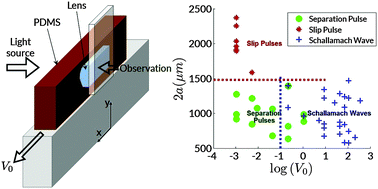Stick-slip at soft adhesive interfaces mediated by slow frictional waves†
Abstract
Stick-slip is a friction instability that governs diverse phenomena from squealing automobile brakes to earthquakes. At soft adhesive interfaces, this instability has long been attributed to Schallamach waves, which are a type of slow frictional wave. We use a contact configuration capable of isolating single wave events, coupled with high speed in situ imaging, to demonstrate the existence of two new stick-slip modes. It is shown that these modes also correspond to the passage of slow waves—separation pulse and slip pulse—with distinct nucleation and propagation characteristics. The slip pulse, characterized by a sharp stress front, propagates in the same direction as the Schallamach wave. In contrast, the separation pulse, involving local interface detachment and resembling a tensile neck, travels in exactly the opposite direction. A change in the stick-slip mode from the separation to the slip pulse is effected simply by increasing the normal force. Taken together, the three waves constitute all possible stick-slip modes in low-velocity sliding. The detailed observations enable us to present a phase diagram delineating the domains of occurrence of these waves. We suggest a direct analogy between the observed slow frictional waves and well known muscular locomotory waves in soft bodied organisms. Our work answers basic questions about adhesive mechanisms of frictional instabilities in natural and engineered systems, with broader implications for slow surface wave phenomena.


 Please wait while we load your content...
Please wait while we load your content...